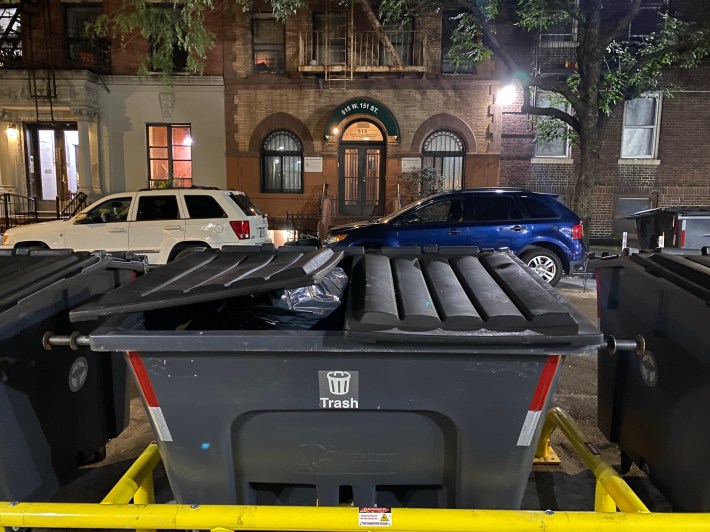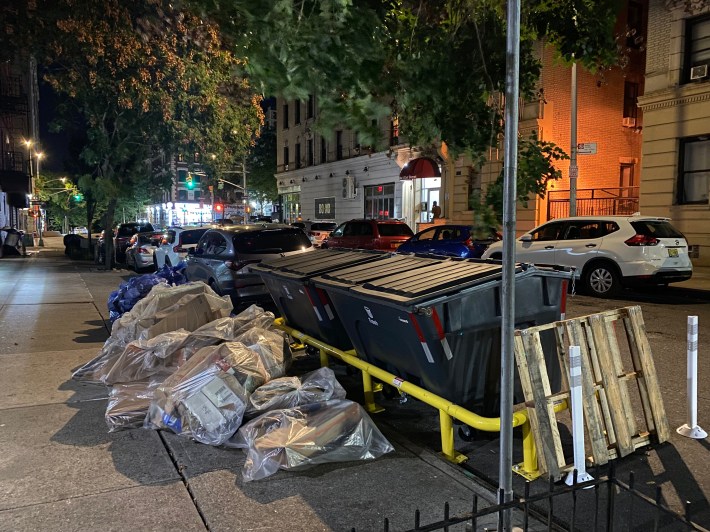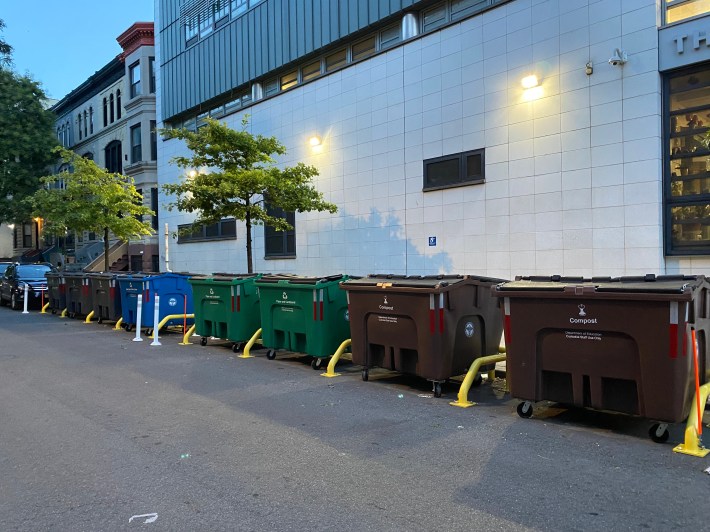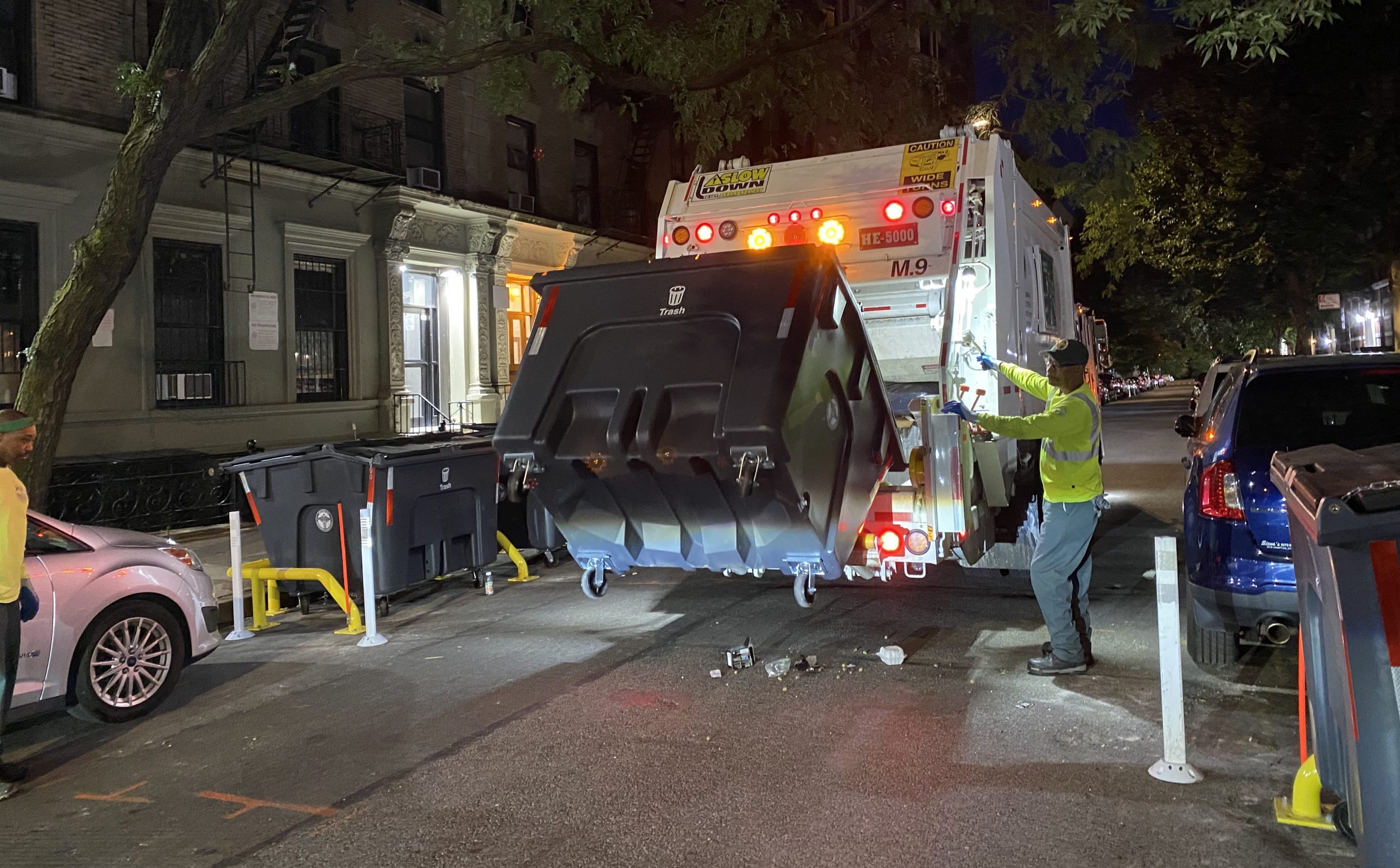It's history in the taking.
New York's Strongest rolled out its latest and best containerized garbage collection pilot uptown using new mechanical lifts at the back of its trucks — the Sanitation Department's biggest step yet toward modern waste management practices.
Officials started installing the curbside containers outside residences and schools in West Harlem over the summer. Sanitation plans to collect the enclosed trash from the 10 residential blocks from W. 143rd and W. 152nd streets, and between Amsterdam Avenue and Broadway, and outside 14 area schools this fall.
It's a small but important step to get rid of the Big Apple’s notorious 5-o'clock shadow of heaps of sidewalk trash and bring New York City closer to the types of trash collection that have long been standard in other global cities like Barcelona, Paris and Buenos Aires.
We’re live from West Harlem where DSNY is piloting automated and containerized garbage collection pic.twitter.com/mfEDD2U5hm
— Kevin Duggan (@kduggan16) September 15, 2023
DSNY last year attempted a different pilot on one block of W. 45th Street in Hells Kitchen — but without automated lifts. Unlike in West Harlem, workers had to haul the bags in the midtown neighborhood one-by-one by hand. Those bins were also locked and only accessible to Sanitation workers and building supers, while the new ones are open.
The agency ended the previous pilot last month.
Harlem's new trash enclosures come grouped in corrals of two to four bins each, in space that was previously allocated for the storage of one or two privately owned cars:

The initiative is part of Mayor Adams’s fight against rats, who feast on the oozing bags that line most sidewalks several days a week. It is also a critical part of regaining public roadway space from the minority of New Yorkers who own cars.
It didn't look like much, but it was history: At the crack of dawn on Friday, a pair of Sanitation workers arrived for collection at W. 151st Street — rolling the dark gray bins to the back of their collection truck to lift and empty the containers.
The bins were largely filled to capacity, even after DSNY doubled collection on the block to six days a week in the lead up to the container program.

The residential part of the bin pilot only covers trash collection so far, meaning recycling bags still lined the sidewalks, a nuisance to pedestrians. Area schools have DSNY containers for recycling and organics.
"We're testing a few different programmatic models as part of the pilot — trash only [at residential [buildings], all streams at schools," said agency spokesman Joshua Goodman.

Some Harlemites said they were excited to be part of the city's latest attempt to clear the foot paths of trash bags and combat rats.
"They should have had it a long time ago," said Jamie Marks, a W. 151st Street resident. "Usually on this block, you see a lot of garbage gets put out, and this keeps it actually clean, sidewalks are clear enough for passage."
“The sidewalks are cleaner for sure," added Andrew Madden, another resident.

There may still be tweaks needed: one building superintendent said some seniors on the block now had to haul their bags further down the street to dump them in the boxes.
"You have older men, 70-75 [years old], are supers of those buildings," said James Bailey. "Now they have to drag the garbage all the way down there."
Another neighbor worried that the bins would become dirty and overflow.
"It annoys me beyond belief that it’s happening on my block," said Thomas G., who declined to give his full last name. "How come it’s not on the block where Mayor Adams has his own rat-infested brownstone in Brooklyn?"
Sanitation workers cleared the upper Manhattan block in just under a half hour, slightly longer than the 15 to 20 minutes it typically takes the agency to clear a street the old way.
One of the workers, who didn't give his name, said he liked the new bins "pretty good," while his partner declined to comment.
In addition to the daily collection Monday through Saturday, the Sanitation Department added 12 extra staff to the local garage to manage the increase, Commissioner Jessica Tisch told the Council during an oversight hearing on Tuesday.
The agency outfitted its existing rear-loader truck fleet with mechanical arms to lift the containers, but officials are also developing a new custom side-loading truck that can lift stationary bins, which officials prefer over the wheeled variety in the long term, according to Tisch.
It could cost around $1 billion to convert DSNY's massive fleet of 2,200 collection trucks, but it will be just as challenging to convince motorists to make room for the enclosures by giving up free parking in a city where even just installing daytime loading zones, outdoor dining, or some Citi Bike docks can quickly become a political third rail.
A DSNY study for citywide containerization from April found the move could work in most parts of the city, but would require the political will to convert public road space that is currently being used — largely for free — by 150,000 drivers, about 10 percent of the city's residential curb space.
At a virtual info session about the program on Tuesday, one participant named Callan lamented to DSNY that his block was losing 15 parking spots, but DSNY pushed back ever so gently.
"We definitely understand that parking spaces will be removed as part of this pilot program, but it's something that we believe is important and necessary," said Jonathan Viguers, an assistant commissioner for outreach.
Adams and local lawmakers have focused the discourse on rats, saying something will have to give in the curb lane to battle the rodent pests.
"Rats are a huge problem uptown, and we’ll never get the problem under control as long as we’re just throwing bags on the sidewalk," said West Harlem Council Member Shaun Abreu. "I look forward to hearing feedback from residents, collecting the data, and walking around the neighborhood without jumping 10 feet in the air."






